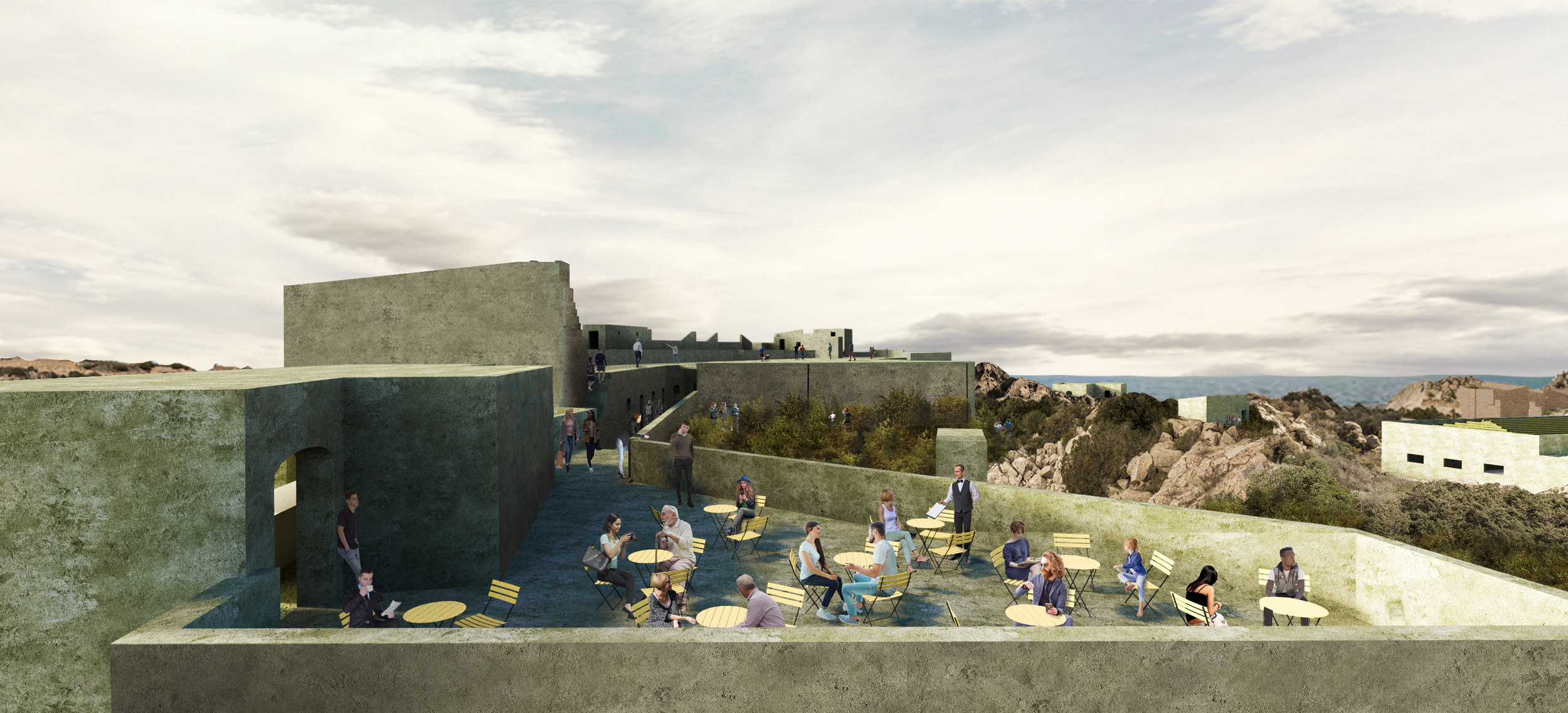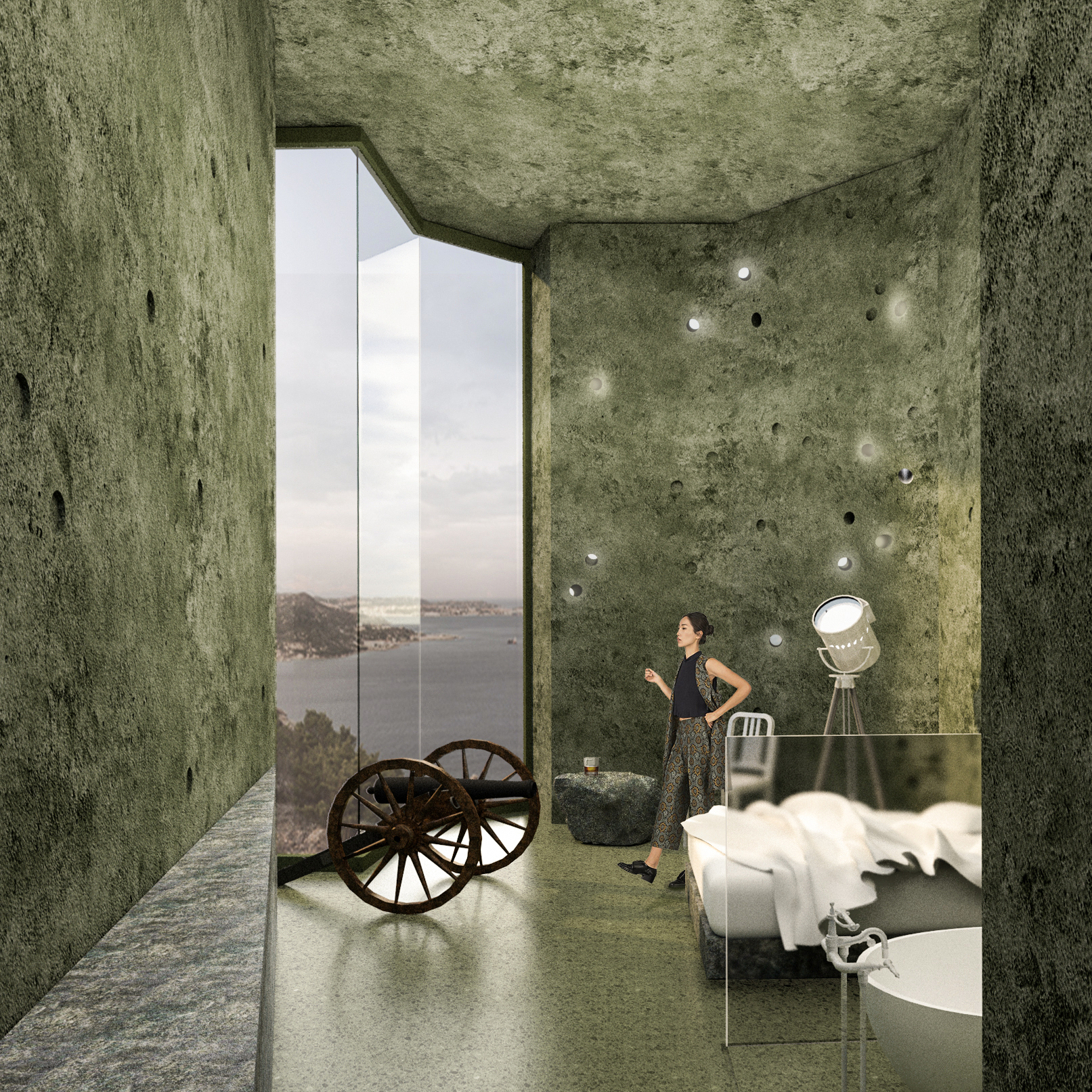Capo d’Orso’s Doppelganger
Competition Entry
2018
Imitation is the sincerest form of flattery.
This project creates a doppelganger of the Capo d’Orso military fortress, abstracting the deeply historic Sardinian ruin. This new ruin will emphasize how tourism is anachronistic, as it allows visitors to deeply understand the site and its old architecture. Today, visiting Capo d’Orso (or any other ruin) is mostly a visual outing. Centuries of tragedy and drama have unfolded on and around this project’s hills, but today the setting is quiet and mute. Tourism cannot inspire relevant feelings since contemporary life is too removed from the events the fortress was built for.
The project’s concept is potently simple: Take the architectural stone ruins and mirror them around a meaningful entry axis, faithfully re-building a copy from concrete, matching every proportion, wall, opening and detail. The shape of the current fortress was a combination of inhabitable buildings or topography enclosed for protection from cannons. Through mimicry, this will all become approximately 2876 square meters of new interior spaces, terraces and courtyards. The new massing will be tinted green to match the site’s olive, fig, and myrtle trees. Similar to military camouflage, the new architecture will be hard to see. This project repeats the architecture that the site already has, to better highlight the ruins and create educational tension. It is formally uninventive, but full of contrasts.
Gate
Visitors will arrive by foot on the path that already serves the ruin. The first building to be copied will be mirrored around an axis that leaves 1 metre of clearance for pedestrians and services. This will naturally cause militaristic single file walking, setting the theme for the entire compound. At this gate-like pinch point, people will be able to touch the old and new structure with outstretched arms, the only time during their whole visit. A courtyard gathering space is surrounded by a ticket sales building and the new library/exhibition building. The ruin’s rotted roofs with exposed timber rafters is quite literally abstracted into new architecture, with glass between the rafters. Rotating exhibitions and a permanent library create the cultural anchor point for the fortress, where facts and dates and history are treated objectively. Washrooms, offices and storage spaces are all discretely located, to not overshadow the primary spaces and the purpose of the new ruin.
Four Small Buildings
Three of the four small buildings are empty. Fortress staff will rent high powered military-grade binoculars to all visitors from the last one. So, ironically, visitors are coerced into experiencing the ruin for the first time at a distance where smart phones can’t take effective pictures and can’t zoom in on the details. Viewpoints out to the Mediterranean and back to the ruins will create feelings of defensiveness and offensiveness, inside claustrophobic and dimly lit outbuildings. The conflicting act of hiding versus hunting will preoccupy all visitors. Camouflaged staff will order the visitors to visit the actual ruins, or to proceed to the fortress hotel.
Hotel
Architectural modernism has been thinning out walls for over 100 years, so material mass is now commonly associated with prisons or luxury. To the contemporary eye, its original protective purpose is lost. The weightiness of the existing ruin becomes remade into an outdoor café, spa, bar restaurant and boutique hotel with quirky occupancy requirements. Guests can only stay for 2 themed nights. One night is in a cell-like room repurposed from the arsenal spaces of the old ruin, and the second night is in a bunker-like bulwark under the cannon platforms. This will distort and exaggerate current attitudes about prospect and outlook.
Night One Room
Without a long view, during active wartime the guest rooms used for Night One would historically have felt safe and secure. Today, a contemporary guest might feel claustrophobic and uncertain. Societal changes about minimum expectations and modern conveniences will be annoyed, through shared bathrooms. Bare bulbs, antique beds, rough green concrete walls, worn concrete floors and the bare necessities will either delight or frustrate. Monastic denial may be luxurious to some guests, but will be deprivation to others.
Night Two Room
A room with a view is freedom in modern life, creating feelings of well-being. During wartime, the void in the fortress was where the death was delivered from, or where it came in. By not providing window coverings, by exposing the green concrete floors and walls, and by cluttering the room with military paraphernalia, some guests may experience feelings of aggravation. These feelings should subside once they close their eyes. The walls are so thick that WIFI wouldn’t work even if it were provided. The space will become oppressive, as if it is trying to squeeze the guest out the artfully angled plate glass window. The only fresh air comes through cannonball openings in the wall.
Spa, Café and Bar
Social interaction and pampering will reinvigorate guests as they recover from their evenings. Daylight was synonymous with safety in historical warfare, which guests will appreciate anew during their stay. As they explore the fortresses’ ruins and the surrounding hillsides they will have feelings of deja vu, and their own temporary anxieties and spatial familiarity will amplify how deeply Capo d’Orso’s history will move them. This green doppelganger is ambiguous enough to not detract from the fortress’s raw beauty or cultural meaningfulness, but strong enough to powerfully affect every visitor’s experience. It is a tragic, interpretive oddity, in an era when tragedy is not a universal experience.






